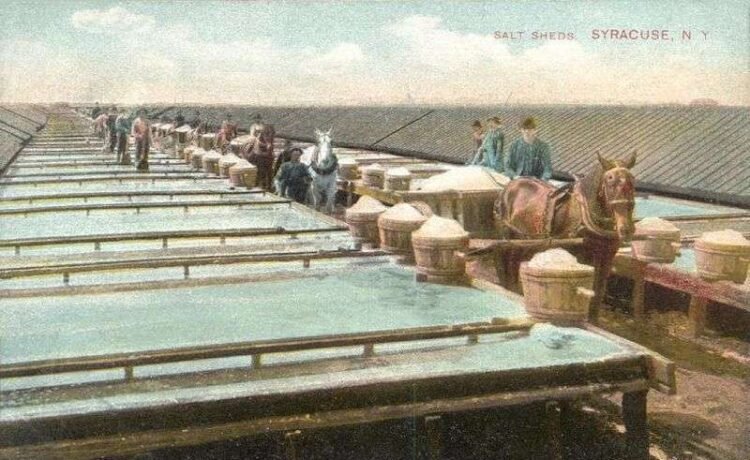
 Before the creation of shaft salt mines, the production of salt in New York State required the evaporation of salt brine extracted from salt springs and wells – first by applying heat and later with large solar evaporators.
Before the creation of shaft salt mines, the production of salt in New York State required the evaporation of salt brine extracted from salt springs and wells – first by applying heat and later with large solar evaporators.
In the mid-19th century it had been thought by New York geologists that the Onondaga salt springs, known since the mid-1600s, must be supplied from the leaching of beds of rock-salt, and for a time efforts were made to find it in the immediate vicinity of Onondaga Lake. The various borings made on the State’s Onondaga Salt Springs Reservation [see map] in the 1820s and 1830s however showed conclusively that no rock salt was there.
With a more careful study of the rocks of the Salina Group it became manifest that those enclosing the gravel-filled basin from which the salt springs flowed were not the ones in which salt could be expected.
The conclusion was drawn that the brine came from the south through an old river channel now filled with gravel and sand and into which flowed the salt water produced by the leaching of beds of salt interstratified with Salina Formation shales.


It remained for the existence of rock-salt thus inferred in this geological horizon to be demonstrated accidentally in the boring of an oil well in Western New York. Between 1878 and 1895, over 35 salt mining companies were formed in New York’s Wyoming and Livingston Counties alone.

 In 1878 salt was found at a depth of 1,279 feet in a well bored for oil in the village of Wyoming, Wyoming County. This well was one of a number bored by order of the Vacuum Oil Company of Rochester at various points in the western part of the state.
In 1878 salt was found at a depth of 1,279 feet in a well bored for oil in the village of Wyoming, Wyoming County. This well was one of a number bored by order of the Vacuum Oil Company of Rochester at various points in the western part of the state.
In this boring a bed of salt 70 feet thick was found. As a result of the discovery of salt at Wyoming a well was bored at LeRoy under a contract between the citizens of that place and the Vacuum Oil Company, by the terms of which the expense was borne by joint subscription.
This well was started in December 1878 and no considerable mass of rock-salt was found, but in March 1879, at a depth of 61o feet a copious supply of brine entered the bore.
In August 1881 a company was organized at Warsaw for the purpose of investigating the deposits underlying that place, and in October salt was found at a depth of 1,620 feet in a well bored near the Buffalo, Rochester and Pittsburg Railroad. The stratum of salt here proved to be 80 feet in thickness.
In 1882 another company, the Crystal Salt Company of Warsaw, sank a well at the locality now known as Saltvale. Here a satisfactory deposit of salt was also found.
In 1883 a well was bored by Dr W. C. Gouinlock near the Buffalo, Rochester and Pittsburg Railroad station. There salt was found on May 5 at a depth of 1,640 feet, and on the same day it was reached in the Stedman, Humphrey and Webster well near the Erie Station in Henrietta, Monroe County.
Following these pioneer explorations a number of companies sank wells and began operations in making salt from brine. The Empire and Hawley Companies located near the Erie Railroad track south of Warsaw, and at Wyoming and Castile salt factories were established during the same year.

 Works of considerable capacity were also erected at Silver Springs in the Town of Gainesville, Wyoming County and began operation in January 1885. Other wells were sunk near the Erie Railroad at Warsaw and the Eldridge well between Warsaw and Rock Glen was bored. Alexander Kerr Bros. & Company of Philadelphia bored a well at Rock Glen.
Works of considerable capacity were also erected at Silver Springs in the Town of Gainesville, Wyoming County and began operation in January 1885. Other wells were sunk near the Erie Railroad at Warsaw and the Eldridge well between Warsaw and Rock Glen was bored. Alexander Kerr Bros. & Company of Philadelphia bored a well at Rock Glen.
In 1883 salt was found in the Genesee Valley. In the vicinity of Greigsville [in the Town of York] a series of test wells were sunk under the direction of Mr C.Q. Freeman, and in September 1884, a shaft was begun in that locality.
In September 1885, salt was there reached at a depth of 995 feet. This deposit is now operated by the Retsof Salt Mining Company. This shaft, believed to have been the first successful salt mine shaft in New York, cost of about $600,000. The shaft salt mine dramatically increased the industry’s production capacity and efficiency.
Near the Genesee River salt works were erected at Piffard by the Livingston Salt Company and about two miles south of Mt Morris by the Lackawanna Company. At Piffard also, works were established by the Genesee Salt Company.
In 1885 works were completed at [the north end of Conesus Lake] in Lakeville [in the Town of Livonia, Livingston County]. In 1886 salt factories were completed at York and others were erected at Cuylervi1le [in the Town of Leicester, in Livingston County].
At Pavilion [in Genesee County] a well was bored reaching a salt bed 64 feet thick. At Pearl Creek Station [in the Town of Covington in Wyoming County] a factory was established with two wells.

 About two miles south of LeRoy station the Lehigh Salt Mining Company has sunk a shaft reaching salt at a depth of 765 feet, and is now [1893-1894] sinking a second shaft [for safety] in compliance with the law. At Livonia and Greigsville other shafts have been sunk.
About two miles south of LeRoy station the Lehigh Salt Mining Company has sunk a shaft reaching salt at a depth of 765 feet, and is now [1893-1894] sinking a second shaft [for safety] in compliance with the law. At Livonia and Greigsville other shafts have been sunk.
Explorations for salt have been made at many points outside of the Oatka Genesee District in Wyoming, Genesee, and Livingston counties.
The locality which is of most interest to the geologist on account of the completeness of the records kept and the large number of wells bored is Tully in Onondaga County by the Solvay Process Company.
These borings are of especial interest because they confirm the conclusions of Professor James Hall [1811-1898] regarding the presence of rock salt south of Syracuse.
Read more about the Salt Industry in New York State.
This essay is extracted from Assistant State Geologist Frederick J.H. Merrill’s “Salt and gypsum industries of New York,” in Bulletin of the New York State Museum, Vol. 3, No. 11, April 1893. It has been edited and annotated by John Warren, who made contextual contributions.
Note on sources: The history of the discovery and development of the salt beds of Western New York was discussed at length by Irving P. Bishop in the Report of the State Geologist for 1884. The growth and development of this industry is best shown by a complete list of producers in 1892-93. Another good source is W. C. Phalen, Salt Resources of the United States, United States Geological Survey Bulletin 668, 1919. Merrill’s “Salt and gypsum industries of New York” contains numerous photos of 19th century salt industry.
Illustrations, from above: Postcard showing solar evaporators and salt sheds around 1908 in Syracuse, NY; “Map of Central New York, Showing Outcrop of the Salina Formation and Locations Where Salt or Brine has Been Found in Wells or Shafts” from W. C. Phalen, Salt Resources of the United States, United States Geological Survey Bulletin 668, 1919; An advertisement for a Wood & Mann steam engine apparatus for drilling made in Utica, NY, and among the first to be used in drilling in the mid-19th century (Beers 1865 Atlas of the Oil Region of Pennsylvania); The Watkins Salt Company evaoprator plants established in 1898 at the south end of Seneca Lake in Watkins Glen, NY, in 1960 before its purchase by Cargill in 1976; and a late 19th century rock salt miner shovels salt into a rail car after explosives were used to loosen the rock.








Recent Comments